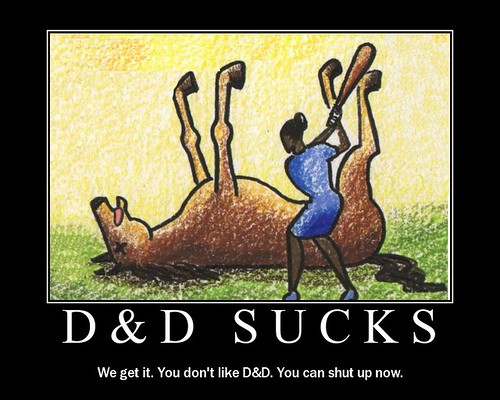Mais um blog.
Back to the Thursday Night Game: You've read a bit about Castle Smoulderthorn. Well, last night was the final session in that adventure (although the campaign will certainly continue). And it started out with a huge social challenge: The PCs find themselves in the sanctum sanctorum with a lich (probably a tough encounter all by himself) and a blue dragon (definitely a climax encounter). I'll cut out a lot of backstory by simply saying that the dragon has been attacking the castle to get to the PCs inside it and the lich isn't sure why either the dragon or the PCs are attacking his floating castle--but he's not happy about it. So a combination negotiation/debate/trial thing happened.
...And out comes a new iteration of our social challenge rules. We extracted a ton of useful data out of the test, and I'll probably spend the rest of the morning typing that up for my colleagues and messing with some the rules. But I can share some broad outlines with you.
1) I had perfect attendance at my table last night: 7 PCs, plus the dragon, plus the lich. A truly participatory social challenge at a table that big is going to be chaotic no matter how you structure it. Or at least you can't come up with rules that muzzle my players.
2) There was a lot of variety in both the mechanical techniques used (the checks/rolls/etc.) and the actual table dialogue. That's a pretty high priority, so it was good to see it emerge in actual play. But my table is predisposed to show those behaviors, so I can't see anything more definite than "it's a good system for people who throw themselves into that play style wholeheartedly."
3) The system we were testing involves skill checks (big surprise, huh?). One of the things I found fascinating was that some players preferred to deliver their dialogue, then roll the skill check and report the result. Others preferred to roll the skill check first, then deliver dialogue that matched their result (good or bad). The system works either way, so I might just make it explicit that you can "roll, then talk" or "talk, then roll." *
4) There is a totally valid D&D playstyle that haaaaates the idea of social interactions being resolved with a die roll. This system should work for that playstyle, too, once you flip a few switches. That just isn't the playstyle we were testing last night.
The upshot? We had about 20 minutes of great dialogue at the table, then the lich was sufficiently convinced that the dragon was dangerously insane that he cautiously aided the PCs in attacking the dragon. Of course the lich turned on the PCs as the dragon fight was winding down. But the social challenge mattered, because the PCs were able to fight the dragon (with a little help), then fight the lich. That sure beats fighting dragon + lich.
Social Challenges: The uninterrupted thinking time on today's run got me to thinking more about Thursday night's playtest. A couple of thoughts.
1) When I talk about "roll, then talk" or "talk, then roll," I think we can pull it off so that some people at the table can do it one way, and others at the table can do it the other way. Or even that a player could shift between 'em from round to round. As long as the DM doesn't provide feedback until both roll and talk are done, then everything works just fine.
2) Reading message board traffic, it doesn't surprise me that people feel strongly about the relative importance of stats-and-rolls vs. at-the-table dialogue. But you know what does surprise me...at least a little? How quickly otherwise-reasonable gamers cross the line into saying, "You're doing it wrong" to people in the other camp. Vive la difference!
3) Eric Noah is pretty good at sussing out our future rules, at least in part. He's clearly had lots of practice, right?
4) Maybe the biggest change that we're contemplating is that no matter where you are on the roll-talk continuum, it's going to be more than a single exchange that determines whether you overcome the challenge. Or at least let me put it this way: A single exchange is as likely to determine a social outcome as a single attack roll is likely to determine a combat outcome.
5) "Exchange" is probably not going to be a game term. I'm just using it like (gasp!) a regular word.
*: Na 3E a gente já jogava assim. Acho que os americanos estão descobrindo o roleplay hehehehe



